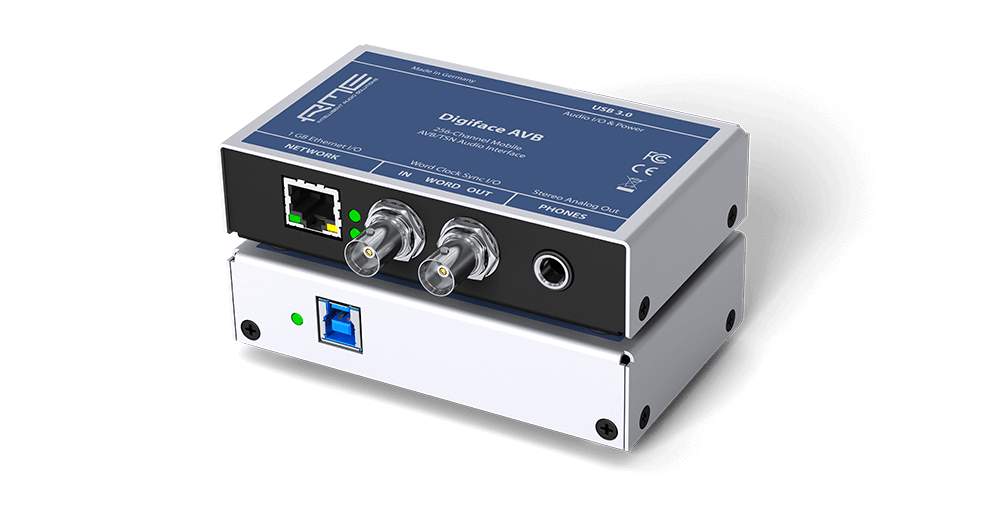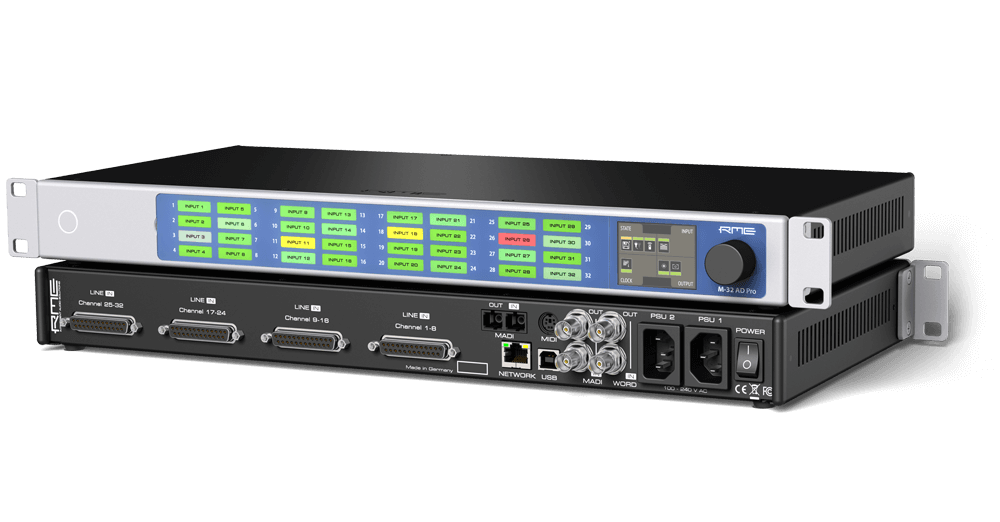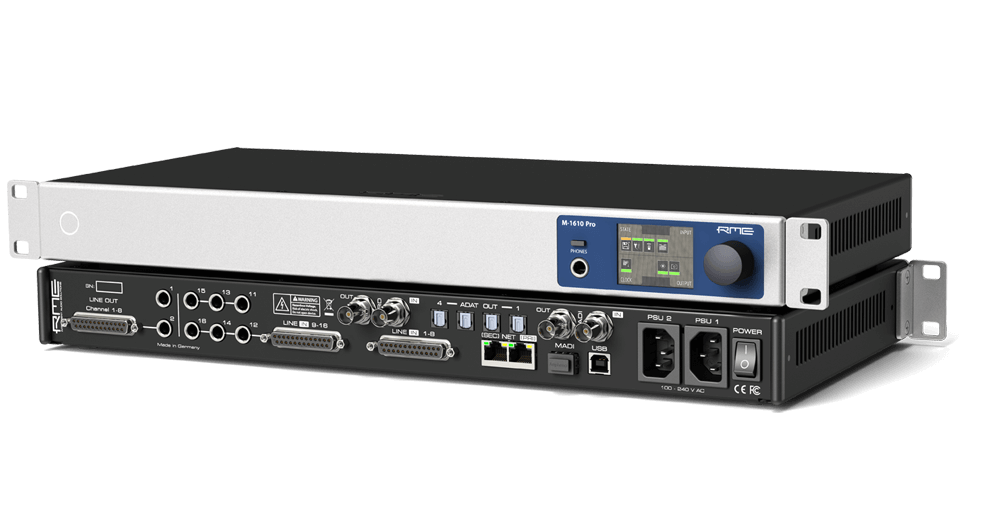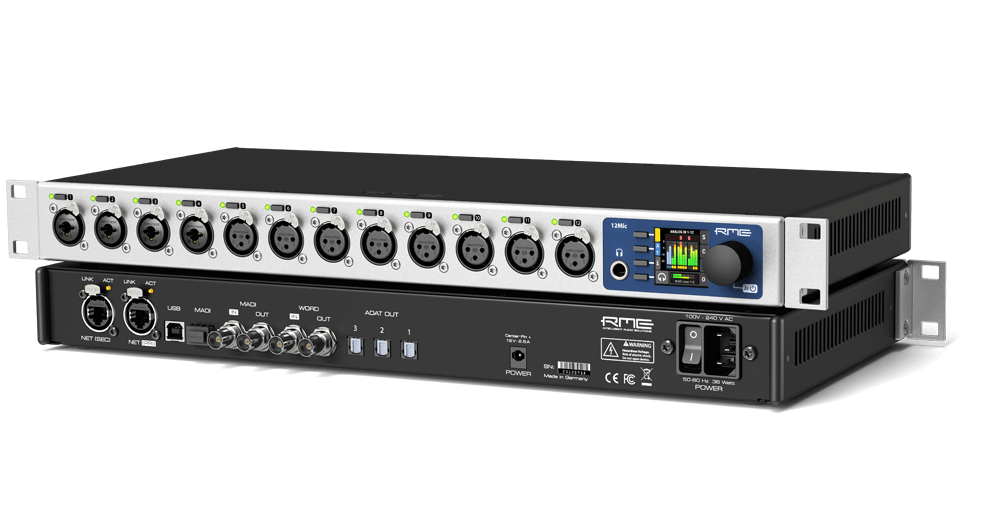AVB Tool
Half-rack MADI-AVB converter with outstanding analog connectivity
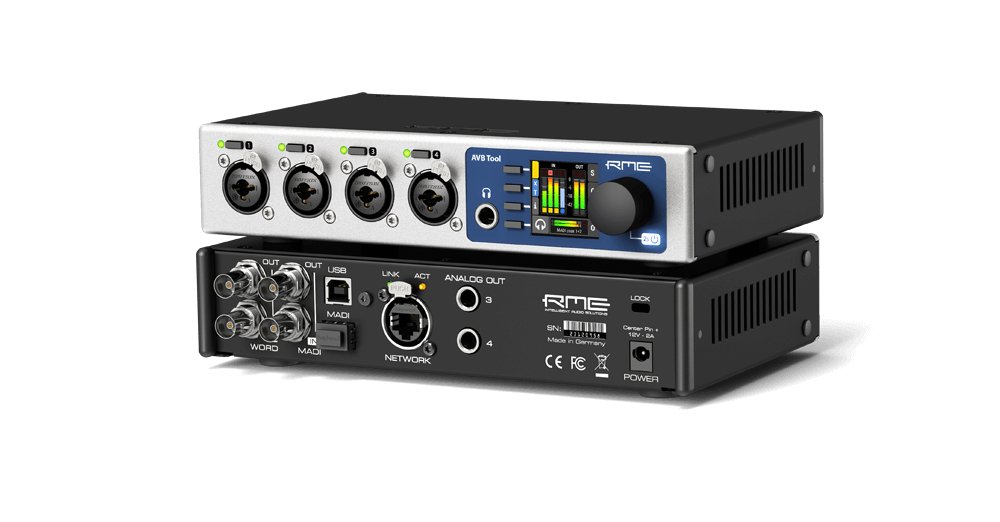
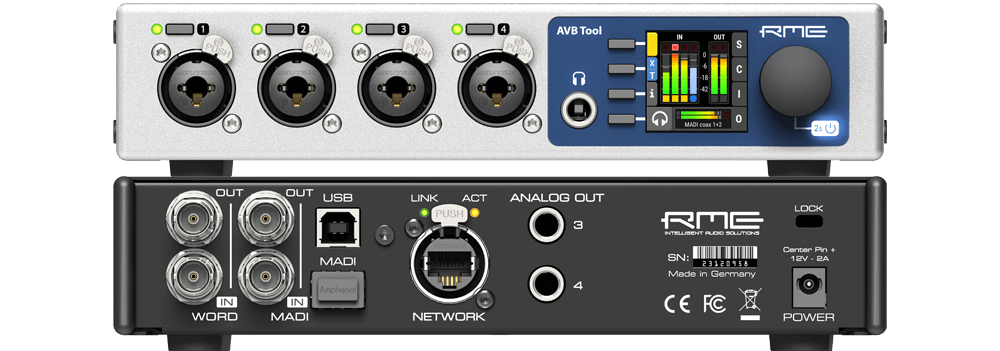
Conexiones y características
High-grade quality analog inputs
The AVB Tool is a pristine analog converter featuring the most commonly-found analog signals in a control room, recording studio or on stage: four XLR-TRS combo inputs, with remote controllable 75 dB gain in 1 dB steps; an input line level sensitivity of +18 dBu, with switchable high impedance on every channel; a stereo headphone output; and two analog line level outputs, with switchable +4/+19 dBu reference levels. Power is provided by an external power supply (with locking connector), and a K-slot lock port adds an additional level of security against theft. Seamless redundancy is available for all MADI signals, whenever the secondary MADI port is mirrored with the same signal as the coaxial MADI input. If redundancy is not required, the (optional) optical single- or multimode MADI module is treated as an individual MADI I/O with full bandwidth.
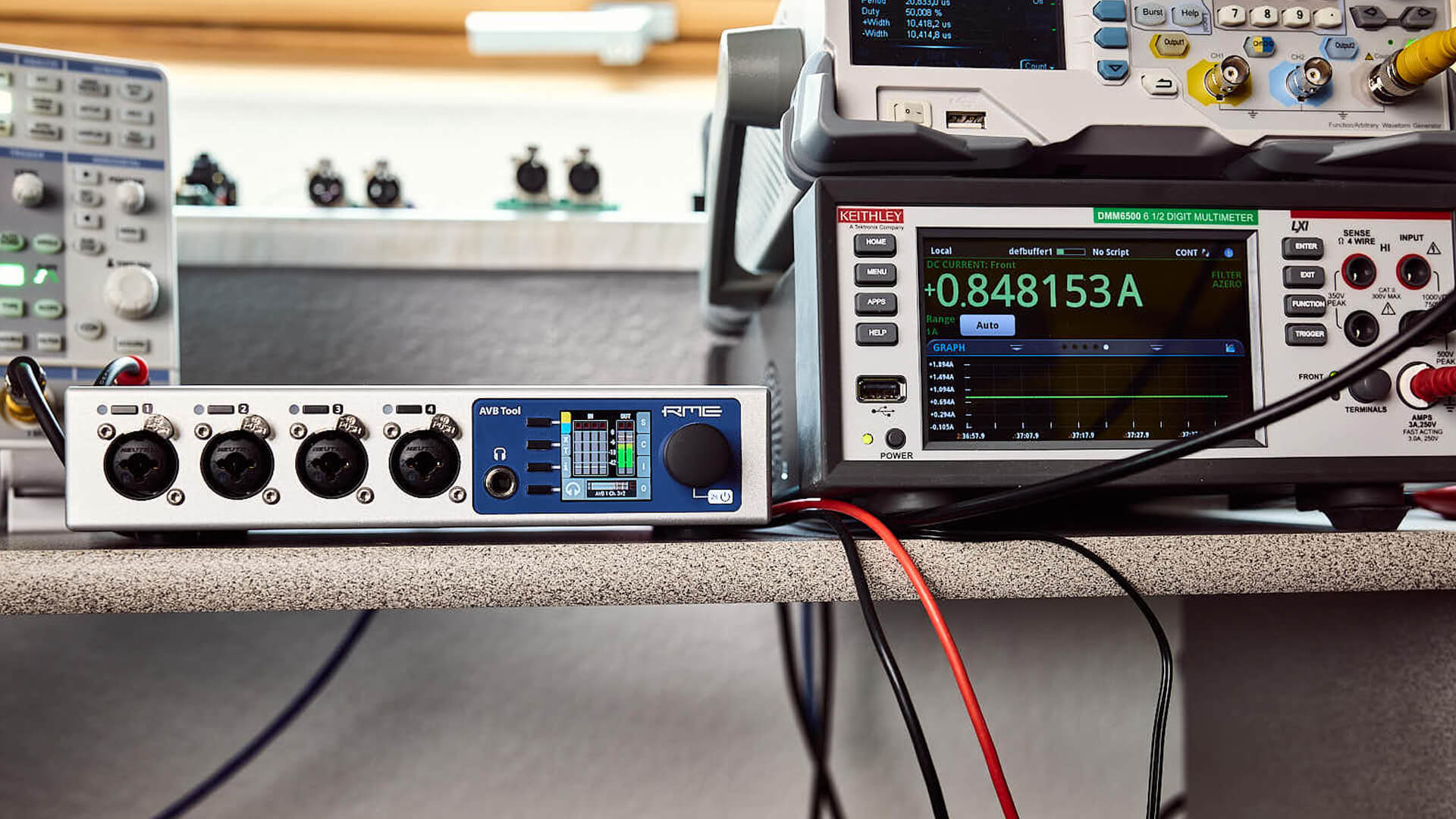
AVB Tool - Ready for use in a variety of applications
8-Stream Gigabit AVB
On the AVB side, the number of streams available in the RME AVB core have been doubled to eight streams in AM824 (legacy AVB) or high-performance AAF (MILAN compatible) format - with configurable size and format per stream. Up to 128 audio channels can be sent and received over AVB in total across all streams. The AVB Tool has the same input stages as the first four channels of the 12Mic – successfully combining the components found in the Fireface UFX II and UFX+ into a new AD converter, extended with switchable High Impedance, balanced line level on the TRS, and two balanced line level outputs at the rear for monitoring.
Plug & play - rapid user interaction
Control all device states directly from the front panel with an encoder and buttons for convenient, direct access to all features. RME AVB devices can also be fully remote controlled via a web-interface on any network link (including wirelessly over Wi-Fi), allowing for the rapid creation of gain groups, phantom power switching, and routing of signals to headphones for monitoring. The integrated routing matrix allows for quick routing of any analog inputs straight to the headphone output, as well as all digital signals and AVB streams. As such, problem-solving of signals, clocking, connectivity or other issues is both simple and straight-forward!
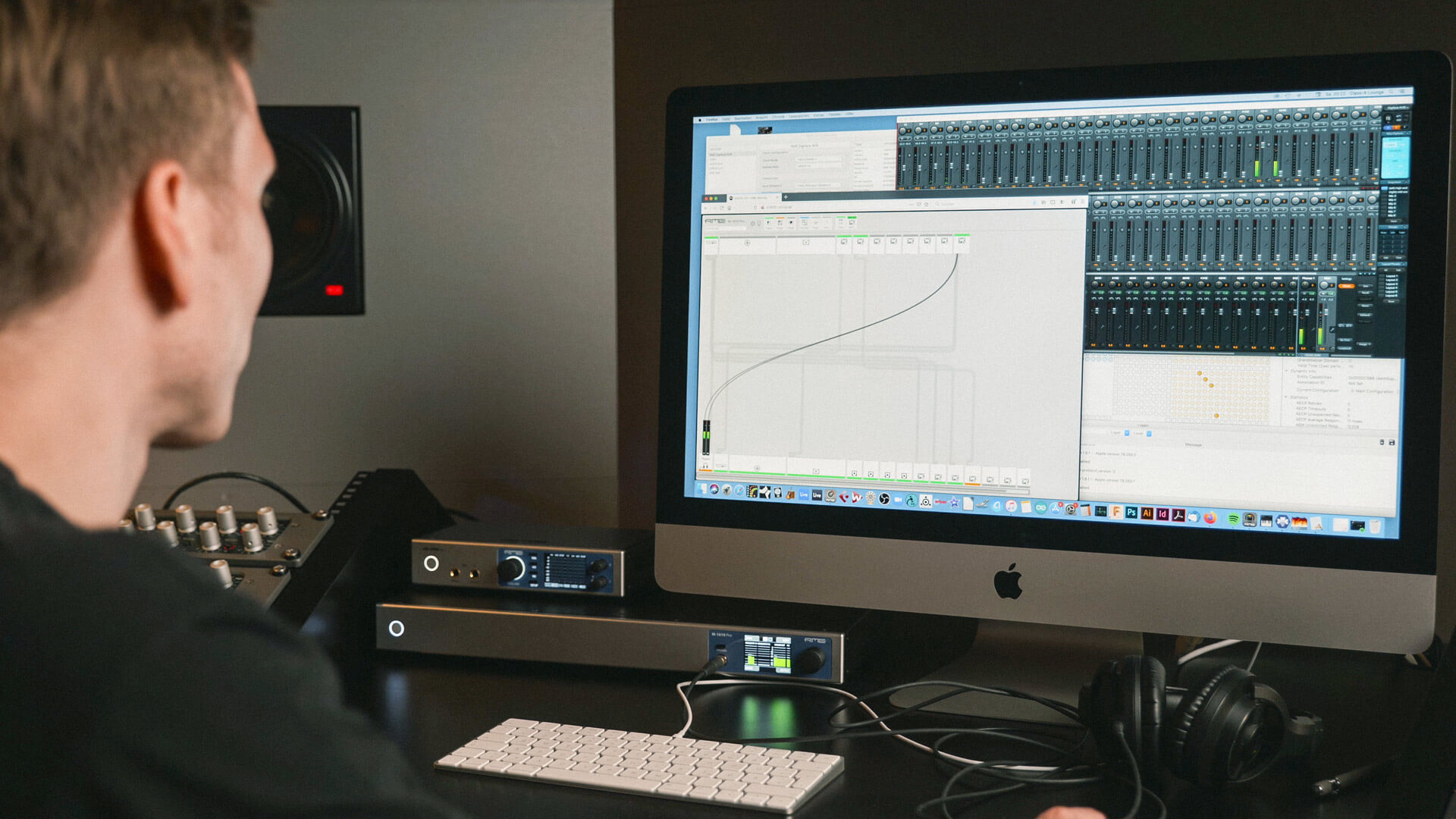
Direct access to all features via the web-interface on any network
SteadyClock FS - Reference class Digital Clocking
In digital audio, the clock frequency is an essential factor, as it creates the correlation between the audio bits and the time reference. Unfortunately, the clock frequency is not always as stable as desired. The AVB Tool offers full SteadyClock FS performance for lowest jitter and highest jitter immunity.
Excellent performance in all clock modes and High Quality Analog Conversion to hear your mix as it is. Digital format conversion in RME products are done without any loss or degredation,and SteadyClock FS ensures your sonic image will never experience degredation. This helps to optimize recordings and mixes because the soundstage has more depth and clarity.
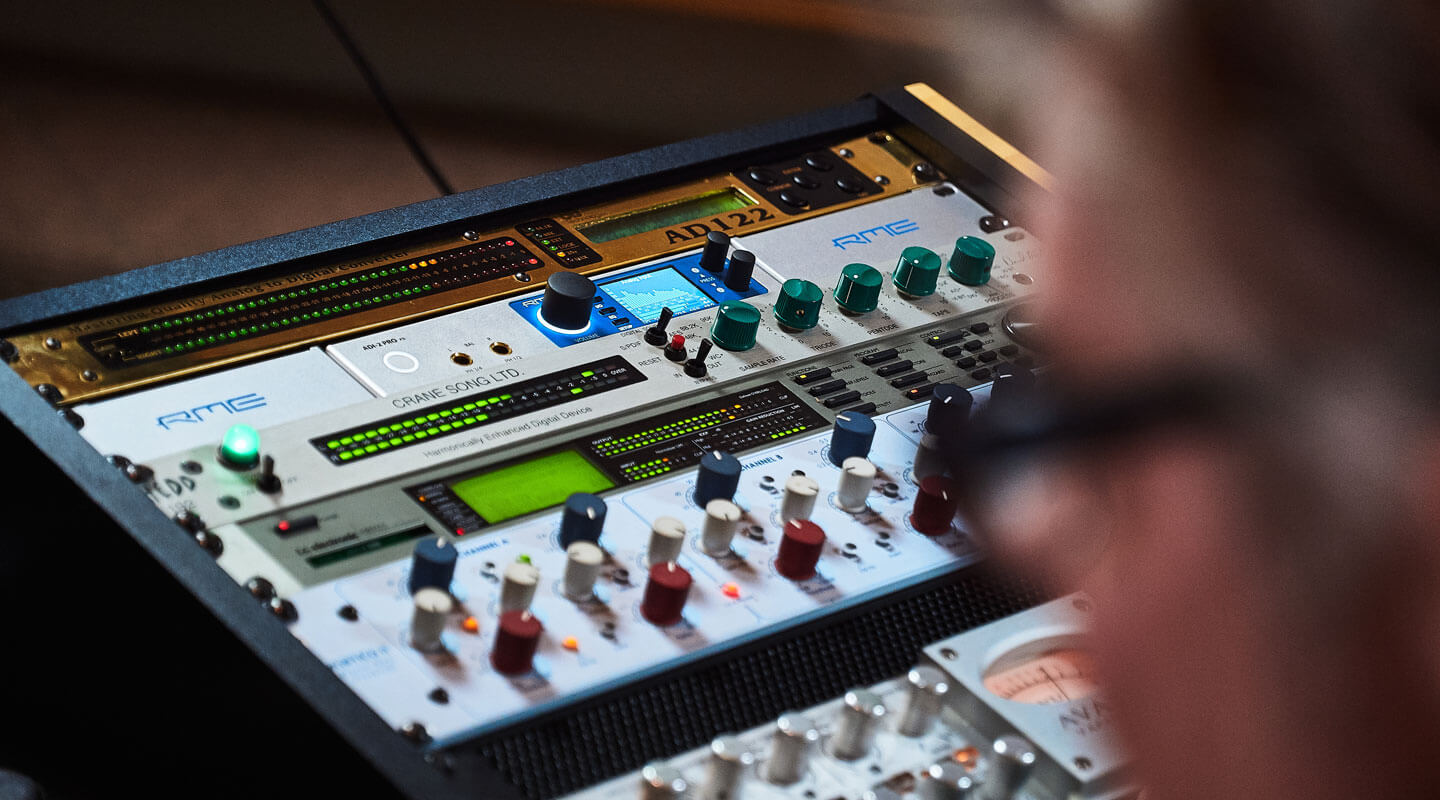
SteadyClock FS Technology from the countless award winning ADI-2 Series
About MADI - Multi Channel Digital Audio Protocol
MADI is a protocol that has evolved alongside RME to be the most widely accepted multi channel digital audio protocol on the market. RME’s MADI-based systems deliver incredible reliability, particularly in applications where failure is not an option.
Accesorios
Optical MADI SFP Module (optional available)
This module extends compatible RME devices with an optical SFP transceiver. Up to 64 audio channels can then be sent to and received from other MADI devices. THE RME SFP module is available in a Multi-Mode and in a Single-Mode version, it can be inserted and removed while the RME MADI device is powered on. It is not necessary to power down the device.
Especif
Inputs
XLR In 1-4:
- Input: XLR, electronically balanced
- Input impedance: 3.4 kOhm
- Gain range: 75 dB, 1 dB steps
- Resolution AD: 24 bit
- Frequency response @ 44.1 kHz, -0.1 dB: 8 Hz – 20.8 kHz
- Frequency response @ 96 kHz, -0.5 dB: 4 Hz – 29.2
- Frequency response @ 192 kHz, -1 dB: 3 Hz – 43.7
- THD @ 30 dB gain: < -110 dB, < 0.00032 %
- THD+N @ 30 dB gain: < -104 dB, < 0.00063 %
- Channel separation: > 110 dB
- Signal to Noise ratio (SNR): > 117 dB RMS unweighted, > 120 dB(A)
- Equivalent Input Noise (EIN), 30 dB Gain: 123 dB RMS unweighted, 125.5 dB(A) @ 150 Ohm
- Maximum input level, Gain 0 dB: +18 dBu
- Maximum input level, Gain 75 dB: -57 dBu
TRS In 1-4:
As above, but:
- Signal to Noise ratio (SNR): 115 dB RMS unweighted, 118 dBA
- TRS jack, balanced
- Gain range: 42 dB, 1 dB steps
- Maximum input level, Gain 8 dB: +20 dBu
- Maximum input level, Gain 50 dB: -22 dBu
- Switchable high impedance (unbalanced TS): 1 MOhm
MADI:
- Coaxial via BNC, 75 Ohm, according to AES10-1991
- Optical via optional SFP module
- 62.5/125 and 50/125 compatible
- Accepts 56 channel and 64 channel mode, plus 96k Frame
- Single Speed: up to 64 channels 24 bit 48 kHz
- Double Speed: up to 32 channels 24 bit 96 kHz
- Quad Speed: up to 16 channels 24 bit 192 kHz
Word Clock:
- 75 ohm Word Clock BNC connectivity
- Support 44.1kHz - 192kHz
- Support full or single speed operation
- SteadyClock FS extracts low jitter clock signal
- Intelligent Clock Control switches clock source seamlessly
Outputs
Analog Out 3/4:
- Output: two 6.3 mm TRS mono (balanced) jacks
- Maximum output level at 0 dBFS: +4 dBu or +19 dBu
Phones 1/2:
- Resolution: 24 Bit
- Noise (DR): 115 dB RMS unweighted, 118 dBA
- Frequency response @ 44.1 kHz, -0.5 dB: 9 Hz – 22 kHz
- Frequency response @ 96 kHz, -0.5 dB: 9 Hz – 45 kHz
- Frequency response @ 192 kHz, -1 dB: 8 Hz - 75 kHz
- THD+N: < -100 dB, < 0.001 %
- Channel separation: > 110 dB
- Output: 6.3 mm TRS stereo (unbalanced) or mono (balanced) jack
- Maximum output level at 0 dBFS: +13 dBu (unbalanced), +19 dBu (balanced)
MADI:
- Coaxial via BNC, 75 Ohm, according to AES10-1991
- Optical via optional SFP module
- 62.5/125 and 50/125 compatible
- Accepts 56 channel and 64 channel mode, plus 96k Frame
- Single Speed: up to 64 channels 24 bit 48 kHz
- Double Speed: up to 32 channels 24 bit 96 kHz
- Quad Speed: up to 16 channels 24 bit 192 kHz
Word Clock:
- 75 ohm Word Clock BNC connectivity
- Support 44.1kHz - 192kHz
- Support full or single speed operation
- SteadyClock FS extracts low jitter clock signal
- Intelligent Clock Control switches clock source seamlessly
General
- 1 x RJ45 1 GigE AVB, 8 streams (each up to 16 ch.) per direction
- MADI input redundancy (requires optional SFP module)
- Internal routing of up to 260x260 channels
- MADI-AVB conversion
- 1,54” full color display with control knob and four buttons for convenient, direct access to all features
- SteadyClock FS - ultra-low jitter digital clock technology
- Remote control via HTTP, JSON, IEEE 1722.1, ATDECC, MIDI over MADI
- USB 2.0 (for remote control and firmware updates)
- DC-coupled outputs
- K-slot lock port
Hardware Specifications
- Dimensions: 215 x 44 x 130 mm (8.5 x 1.7 x 5.1 inches)
- Weight: 1.0 kg (2.2 lbs)
- Package: 347 x 216 x 83 mm (13.7 x 8.5 x 3.3 inches)
- Conformity: CE, FCC, WEEE, RoHS
- Power supply: external 2 A 100-240 V AC
- Power consumption: typ. 13W, standby 0.5W
- Power consumption: typ. 20 W, standby 0.5W
All specifications are subject to change without notice.
Controladores
Version 2.0.0 with support for the 12Mic, 12Mic-D, AVB Tool and OctaMic XTC, requires macOS 10.15 or newer!
Version 2.0.0 with support for the 12Mic, 12Mic-D, AVB Tool and OctaMic XTC, requires macOS 10.15 or newer!
Version 1.0.0 with support for the 12Mic, AVB Tool, and OctaMic XTC.
Version 2.0.0 with support for the 12Mic, 12Mic-D, AVB Tool and OctaMic XTC, requires Windows 10 or newer!
Version 1.0.0 with support for the 12Mic, AVB Tool, and OctaMic XTC.
Firmware 1.7.1. Main update. Carefully read the instructions in the readme.pdf!
